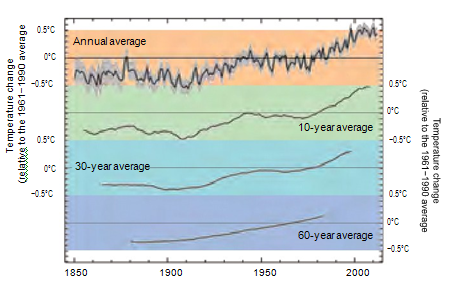
figure 4. As the climate system
varies naturally from year to year
and from decade to decade, reliable
inferences about human-induced
climate change must be made with
a longer view, using multi-decadal
and longer records. Calculating a
‘running average’ over these longer
timescales allows one to more easily
see long-term trends. For the global
average temperature for the period
1850-2012 (using the data from
the UK Met Office Hadley Centre
relative to the 1961-90 average) the
plots show: (top) the average and
range of uncertainty for annually
averaged data; (2nd plot) the
temperature given for any date is
the average for the ten years about
that date; (3rd plot) the equivalent
picture for 30-year; and (4th plot)
the 60-year averages. Source: Met
Office, based on the HadCRUT4 dataset
from the Met Office and Climatic
Research Unit (Morice et al., 2012). | Yes. The observed warming rate has varied from year to year, decade to decade, and place
to place, as is expected from our understanding of the climate system. These shorterterm
variations are mostly due to natural causes, and do not contradict our fundamental
understanding that the long-term warming trend is primarily due to human-induced
changes in the atmospheric levels of CO2 and other greenhouse gases. Even as CO2 is rising steadily in the atmosphere, leading to gradual warming of Earth’s surface, many natural
factors are modulating this long-term warming. Large volcanic eruptions increase the number of small
particles in the stratosphere that reflect sunlight, leading to short-term surface cooling lasting typically two
to three years, followed by a slow recovery. Ocean circulation and mixing vary naturally on many time scales,
causing variations in sea surface temperatures as well as changes in the rate at which heat is transported to
greater depths. For example, the tropical Pacific swings between warm El Niño and cooler La Niña events
on timescales of two to seven years. Scientists know of and study many different types of climate variations,
such as those on decadal and multi-decadal timescales in the Pacific and North Atlantic Oceans, each with
its own unique characteristics. These oceanic variations are associated with significant regional and global
shifts in temperature and rainfall patterns that are evident in the observations.
Warming from decade to decade can also be affected by human factors such as variations in the emissions,
from coal-fired power plants and other pollution sources, of greenhouse gases and of aerosols (airborne
particles that can have both warming and cooling effects).
These variations in the temperature trend are clearly evident in the observed temperature record [Figure
4]. Short-term natural climate variations could also affect the long-term human-induced climate change
signal and vice-versa, because climate variations on different space and timescales can interact with
one another. It is partly for this reason that climate change projections are made using climate models
(see infobox, p.20) that can account for many different types of climate variations and their interactions.
Reliable inferences about human-induced climate change must be made with a longer view, using records
that cover many decades. |